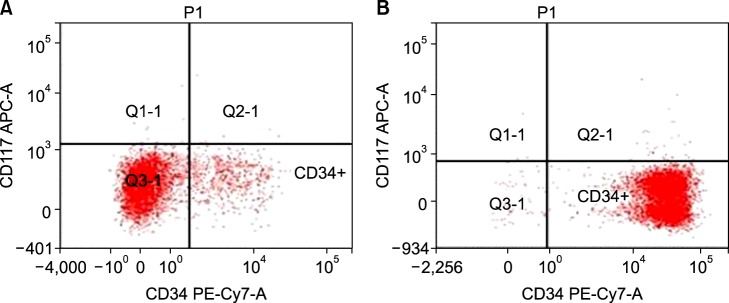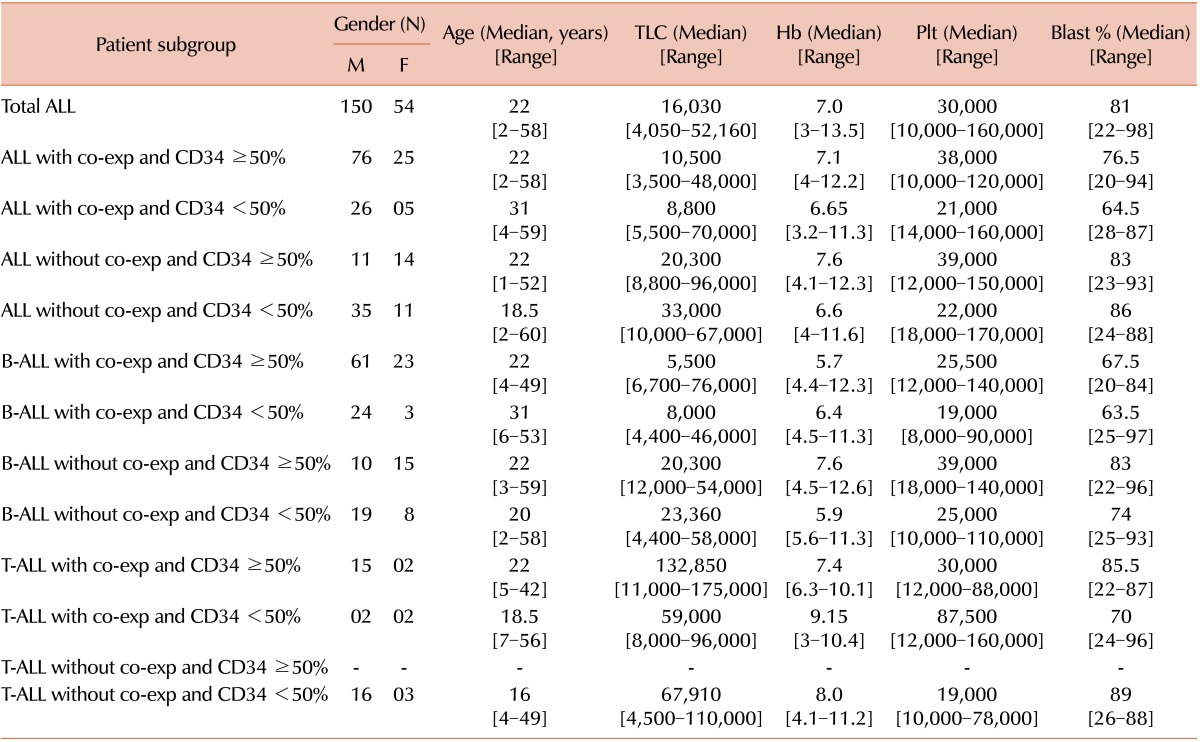1. Tijchon E, Havinga J, van Leeuwen FN, Scheijen B. B-lineage transcription factors and cooperating gene lesions required for leukemia development. Leukemia. 2013; 27:541–552. PMID:
23047478.

2. Drexler HG, Thiel E, Ludwig WD. Review of the incidence and clinical relevance of myeloid antigen-positive acute lymphoblastic leukemia. Leukemia. 1991; 5:637–645. PMID:
1886419.
3. Shen HQ, Tang YM, Yang SL, et al. Immunophenotyping of 222 children with acute leukemia by multi-color flow cytometry. Zhonghua Er Ke Za Zhi. 2003; 41:334–337. PMID:
14751050.
4. Vitale A, Guarini A, Ariola C, et al. Absence of prognostic impact of CD13 and/or CD33 antigen expression in adult acute lymphoblastic leukemia. Results of the GIMEMA ALL 0496 trial. Haematologica. 2007; 92:342–348. PMID:
17339183.

5. Sobol RE, Mick R, Royston I, et al. Clinical importance of myeloid antigen expression in adult acute lymphoblastic leukemia. N Engl J Med. 1987; 316:1111–1117. PMID:
3494942.

6. Uckun FM, Sather HN, Gaynon PS, et al. Clinical features and treatment outcome of children with myeloid antigen positive acute lymphoblastic leukemia: a report from the Children's Cancer Group. Blood. 1997; 90:28–35. PMID:
9207434.
7. Katz FE, Tindle R, Sutherland DR, Greaves MF. Identification of a membrane glycoprotein associated with haemopoietic progenitor cells. Leuk Res. 1985; 9:191–198. PMID:
3857408.

8. van Stijn A, van der Pol MA, Kok A, et al. Differences between the CD34+ and CD34- blast compartments in apoptosis resistance in acute myeloid leukemia. Haematologica. 2003; 88:497–508. PMID:
12745269.
9. Oyan AM, Bo TH, Jonassen I, et al. CD34 expression in native human acute myelogenous leukemia blasts: differences in CD34 membrane molecule expression are associated with different gene expression profiles. Cytometry B Clin Cytom. 2005; 64:18–27. PMID:
15668952.
10. Borowitz MJ, Shuster JJ, Civin CI, et al. Prognostic significance of CD34 expression in childhood B-precursor acute lymphocytic leukemia: a Pediatric Oncology Group study. J Clin Oncol. 1990; 8:1389–1398. PMID:
1696310.

11. Terstappen LW, Safford M, Konemann S, et al. Flow cytometric characterization of acute myeloid leukemia. Part II. Phenotypic heterogeneity at diagnosis. Leukemia. 1992; 6:70–80. PMID:
1540262.
12. Jennings CD, Foon KA. Recent advances in flow cytometry: application to the diagnosis of hematologic malignancy. Blood. 1997; 90:2863–2892. PMID:
9376567.

13. Pui CH, Behm FG, Crist WM. Clinical and biologic relevance of immunologic marker studies in childhood acute lymphoblastic leukemia. Blood. 1993; 82:343–362. PMID:
8329694.

14. Pui CH, Raimondi SC, Hancock ML, et al. Immunologic, cytogenetic, and clinical characterization of childhood acute lymphoblastic leukemia with the t(1;19) (q23; p13) or its derivative. J Clin Oncol. 1994; 12:2601–2606. PMID:
7989935.

15. Borkhardt A, Cazzaniga G, Viehmann S, et al. Associazione Italiana Ematologia Oncologia Pediatrica and the Berlin-Frankfurt-Munster Study Group. Incidence and clinical relevance of TEL/AML1 fusion genes in children with acute lymphoblastic leukemia enrolled in the German and Italian multicenter therapy trials. Blood. 1997; 90:571–577. PMID:
9226156.

16. De Zen L, Orfao A, Cazzaniga G, et al. Quantitative multiparametric immunophenotyping in acute lymphoblastic leukemia: correlation with specific genotype. I. ETV6/AML1 ALLs identification. Leukemia. 2000; 14:1225–1231. PMID:
10914546.

17. Pui CH, Frankel LS, Carroll AJ, et al. Clinical characteristics and treatment outcome of childhood acute lymphoblastic leukemia with the t(4;11)(q21;q23): a collaborative study of 40 cases. Blood. 1991; 77:440–447. PMID:
1991161.
18. Pui CH, Hancock ML, Head DR, et al. Clinical significance of CD34 expression in childhood acute lymphoblastic leukemia. Blood. 1993; 82:889–894. PMID:
7687897.

19. Vanhaeke DR, Bene MC, Garand R, Faure GC. Expression and long-term prognostic value of CD34 in childhood and adult acute lymphoblastic leukemia. Leuk Lymphoma. 1995; 20:137–142. PMID:
8750635.

20. Thomas X, Archimbaud E, Charrin C, Magaud JP, Fiere D. CD34 expression is associated with major adverse prognostic factors in adult acute lymphoblastic leukemia. Leukemia. 1995; 9:249–253. PMID:
7532767.
21. Craddock KJ, Chen Y, Brandwein JM, Chang H. CD13 expression is an independent adverse prognostic factor in adults with Philadelphia chromosome negative B cell acute lymphoblastic leukemia. Leuk Res. 2013; 37:759–764. PMID:
23643324.






 PDF
PDF ePub
ePub Citation
Citation Print
Print





 XML Download
XML Download